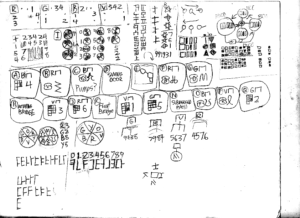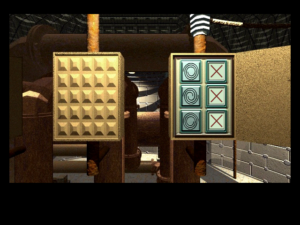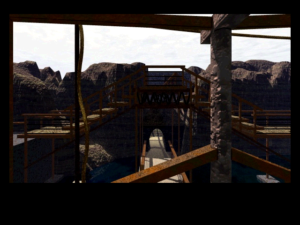DROD RPG: Sort of complete
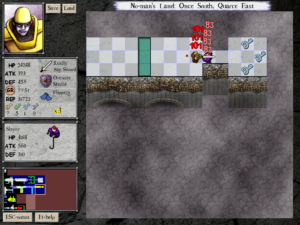 I know I just compared DROD RPG to Time Zone, but by the end, it was reminding me more of my experiences with Rhem. As I cleared paths of their obstacles, unlocking gates and killing monsters who stand in the way, the area I was playing in effectively expanded, until I was playing with the whole dungeon rather than just my immediate vicinity. As in Rhem, I spent so much time running madly from place to place to do stuff I wasn’t prepared for the first time through that I pretty much internalized the map, which led to beating the rest of the game in a manic burst rather than take a break and lose my place. When I talk about backtracking, I’m not just talking about going back for special items, although that was part of it, but also for stuff as simple as the monsters who were too tough for me initially, but who could now be easily killed for their money, which I could use to upgrade my stats, enabling me to mug even tougher monsters. At any rate, it’s a real contrast to regular DROD, where you generally leave solved areas behind and don’t look back.
I know I just compared DROD RPG to Time Zone, but by the end, it was reminding me more of my experiences with Rhem. As I cleared paths of their obstacles, unlocking gates and killing monsters who stand in the way, the area I was playing in effectively expanded, until I was playing with the whole dungeon rather than just my immediate vicinity. As in Rhem, I spent so much time running madly from place to place to do stuff I wasn’t prepared for the first time through that I pretty much internalized the map, which led to beating the rest of the game in a manic burst rather than take a break and lose my place. When I talk about backtracking, I’m not just talking about going back for special items, although that was part of it, but also for stuff as simple as the monsters who were too tough for me initially, but who could now be easily killed for their money, which I could use to upgrade my stats, enabling me to mug even tougher monsters. At any rate, it’s a real contrast to regular DROD, where you generally leave solved areas behind and don’t look back.
Mind you, when I say that I beat the game, I’m only talking about getting to the end credits. There’s an extra boss in a secret area just off the final exit, and I suppose I won’t be fully satisfied until I do him in. Without him, the final boss is a Slayer, which would be more satisfying if I hadn’t already killed one in the secret level of chapter 1. (In particular, when you first see him, his projected damage is ridiculously astronomical, due to the combat mechanic’s nonlinear response to power differences. It’s a nice “You gotta be kidding me” moment, but you only get one of those per enemy.) But that’s what you get when you play the game out of intended order. The designers were clearly thinking in terms of players completing the game the easy way first and only afterward going back for the secrets. That’s why the new items in the secret level were unexplained; when you encounter them over the normal course of chapter 2, there’s usually a helpful guy 1That’s his name within the game engine. Helpful Guy. It says so when you click on him. nearby to describe them.
I have a pretty clear idea of what I have to do to beat this extra boss, although in order to pull it off, I’ll have to defer getting the Really Big Sword until much later in the game. That’ll make things difficult. Getting the Really Big Sword was a turning point for me, where I suddenly started being able to easily get health significantly faster than I spent it. I suppose I should have taken that as a warning. If it seems easy, you’re doing it wrong. Paradoxical though that is, it could be this game’s motto.
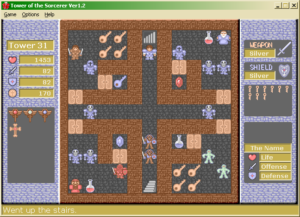 A day or two before my final push, I saw a mention on the DROD forum of Tower of the Sorcerer, a freeware game by “Oz and Kenichi” that allegedly used the same combat system as DROD RPG. Well, the similarities don’t end there. Both games are based on managing health and three different colors of keys (one of which is reserved for plot-crucial doors). I think the most striking point of resemblance is the devices for using money to raise your stats, which function nearly identically in both games, offering you a choice of health, attack power or defense power (with attack increases substantially less than defense increases), increasing the price with each use, increasing the gains as you get to remoter instances of the device (thus motivating you to hold off on upgrades until you can reach a more powerful one). Is DROD RPG a rip-off, then? Hardly. It’s based on TotS, and acknowledges this debt in the credits, but it also adds quite a bit of complexity. From what I’ve seen, TotS doesn’t seem to have anything like the percent-based damage from hot tiles and aumtlichs, and it definitely doesn’t have any way of doing stuff like trying to work your way around a goblin in a tight passage without turning your back to it (one of my favorite puzzle-like bits in DROD RPG). And anyway, I think the folks at Caravel Games earned our indulgence on this point through their indulgence of Wonderquest, which is about as direct a DROD imitation as you could hope to find (although it’s also embellished), and has a section of the official DROD forum devoted to it.
A day or two before my final push, I saw a mention on the DROD forum of Tower of the Sorcerer, a freeware game by “Oz and Kenichi” that allegedly used the same combat system as DROD RPG. Well, the similarities don’t end there. Both games are based on managing health and three different colors of keys (one of which is reserved for plot-crucial doors). I think the most striking point of resemblance is the devices for using money to raise your stats, which function nearly identically in both games, offering you a choice of health, attack power or defense power (with attack increases substantially less than defense increases), increasing the price with each use, increasing the gains as you get to remoter instances of the device (thus motivating you to hold off on upgrades until you can reach a more powerful one). Is DROD RPG a rip-off, then? Hardly. It’s based on TotS, and acknowledges this debt in the credits, but it also adds quite a bit of complexity. From what I’ve seen, TotS doesn’t seem to have anything like the percent-based damage from hot tiles and aumtlichs, and it definitely doesn’t have any way of doing stuff like trying to work your way around a goblin in a tight passage without turning your back to it (one of my favorite puzzle-like bits in DROD RPG). And anyway, I think the folks at Caravel Games earned our indulgence on this point through their indulgence of Wonderquest, which is about as direct a DROD imitation as you could hope to find (although it’s also embellished), and has a section of the official DROD forum devoted to it.
Finally, let’s talk plot a little. Chapter 1 is about Tendry’s escape from the Beneath, chapter 2 supposedly about his rescue of his countrymen who had been abducted by the Empire. We don’t actually get to see him do the latter, though, unless there’s something past the secret boss. There’s a distinct non-ending and promise of sequels, and, well, we’ll see how that turns out. On the other hand, the Empire is discussed enough that I think I’m finally starting to grasp the DROD overplot.
As I understand it, the Empire has two major factions, the Archivists and the Patrons, who split on how they approach the pursuit of knowledge. The Archivists are trying to get all the facts, whereas the Patrons are trying to get as many facts as possible. These might sound like similar goals, but they disagree when it comes to things that generate new facts — for example, foreigners. The Patrons like such things, because they’re an endless source of new things to learn, while the Archivists dislike them, because they perpetually render the Archivists’ knowledge incomplete. Thus, the Archivists want to destroy foreigners while the Patrons want to protect them. (Yes, only bad guys are completists.) It’s the Patrons who move the entire population of Tueno underground, which Tendry sees at first only as an enemy action, not realizing that they’re doing it to save them all from the Archivists’ army. The thing that hasn’t been resolved is what the Patrons intend to do with all these people. Fight a decisive battle against the Archivists and return them to their homes? Release them elsewhere, where the Archivists won’t find them immediately? Keep them in cages and study them? Tendry comments at one point about the Patrons “collecting” his people, which makes me think this isn’t supposed to be a temporary condition. The Archivists are evil, but you have to bear in mind that the Patrons are products of the same deranged system. Who knows what they’re capable of? Not me, certainly. The ending of that story has not yet been written.
| ↑1 | That’s his name within the game engine. Helpful Guy. It says so when you click on him. |
|---|
 Comments(2)
Comments(2)